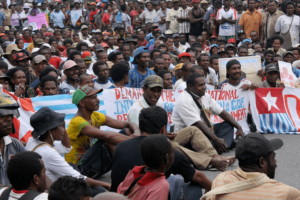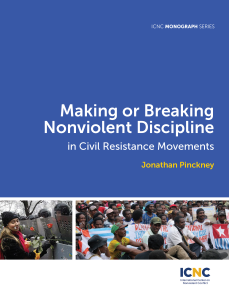This Academic Webinar took place on Tuesday, January 17, 2017 at 12 p.m. EST
This webinar was presented by Jonathan Pinckney
Watch the webinar below:
Webinar content:
1. Introduction of the Speaker: 00:00-00:52
2. Presentation: 00:52- 29:20
3. Questions and Answers: 29:20-52:29
Two different polls were conducted among the participants during the webinar. The polls asked the following questions:
- In your opinion, how important is nonviolent discipline for the success of a civil resistance movement?
- In your view, what factors increase nonviolent discipline in civil resistance movements?
Check the webinar recording above to see the polls’ results that reflected the views’ of the webinar participants and compare them with the quantitative and qualitative findings of the research presented by the speaker.
Webinar summary:
How can we understand when nonviolent movements will stay nonviolent? When are they likely to break down into violence? In this monograph, Jonathan Pinckney analyzes both what promotes and undermines nonviolent discipline in civil resistance movements. Combining quantitative research on thousands of nonviolent and violent actions with a detailed comparison of three relevant case studies of civil resistance during the “Color Revolutions”, Pinckney’s analysis provides important lessons for activists and organizers on the front lines, as well as for practitioners whose work may impact the outcomes of nonviolent struggles. We learn how repression consistently induces violence, as do government concessions. On the flip side, we see that structuring a campaign in an inclusive and non-hierarchical way is conducive to greater nonviolent discipline.
Responses to questions not answered during the scheduled webinar time:
Participant comment/question: hanks for studying this topic. I’m in the US, and I’ve dealt with people who come to demonstrations and civil disobedience actions as participants in and advocates of “black bloc” style “diversity of tactics.” Many of the anti-corporate globalization mobilizations faced these challenges, and for a while even advocates of nonviolence seemed to try to split the difference with “black blocs.” But my perception is that this didn’t work (splitting the difference seemed to mean, in practice, rejecting what you call nonviolent discipline). And I think many advocates (the RANT collective, for example, I believe) reaffirmed advocacy for explicitly nonviolent agreements for demonstrations. I’m wondering, either in your case studies or your interest in the field, if you’ve studied the negotiation process between advocates and skeptics of explicitly nonviolent approaches.
Pinckney: This is definitely a major challenge for several movements, and it’s very typical to see back and forth struggles between groups who are committed to nonviolence and those who either explicitly espouse violence or at least want to keep their options open to a “diversity of tactics,” as you mention. I haven’t studied that negotiation process in depth, but I can tell that it’s certainly difficult. Some movements attempt to distance themselves from groups that don’t explicitly commit to nonviolence, others try to talk them into moderating or limiting their violent activities. It’s a process that’s very specific to the particular case, depending on what the power balance is between different groups, their connection to the larger social-political environment, etc.
Participant comment/question: I’m a little confused about your statistical tests, including the “statistical results” column. Were you testing these three cases alone, or bringing in other examples as well?
Pinckney: For my statistical testing I looked at around 18,000 actions by hundreds of different campaigns in 14 countries over a period of around twenty years. The countries were completely different than the three countries that I examined for the comparative cases section. That’s why you might have noticed that sometimes the findings were different for the statistical testing than for the three [in-depth] cases. I was particularly convinced by findings where I could see a pattern both in the statistical testing and in the three cases. I discuss where the data for the statistical testing comes from in great detail in my ICNC monograph.
Presenter

Jonathan Pinckney is a PhD candidate at the Josef Korbel School of International Studies, University of Denver, and a research fellow at the Sie Cheou-Kang Center for International Security and Diplomacy, where he supervises the Nonviolent and Violent Campaigns and Outcomes (NAVCO) 3.0 project. His research centers on nonviolent political contention in non-democracies, which special focus on the role of civil resistance in democratization. Jonathan’s work has been published in the Journal of Peace Research, Foreign Policy Magazine’s Democracy Lab, and the Encyclopedia of Social and Behavioral Sciences. Jonathan received his BA in International Affairs from Gordon College, graduating summa cum laude with special honors, and his MA from the Korbel School in 2014. He was a 2012 recipient of the Korbel School’s Sie Fellowship.
Making or Breaking Nonviolent Discipline in Civil Resistance Movements monograph
Recommended Readings:
- Hardy Merriman. “The Trifecta of Civil Resistance.”
- Liesel Mitchell. “Nonviolent Discipline: A Comparative Analysis of Tiananmen Square 1989 and Gwangju 1980.”
- Gene Sharp. “How Nonviolent Struggle Works.” (A shorter version of The Politics of Nonviolent Action that is available online) Chapter 11: Solidarity and Discipline to Fight Repression.
Upcoming ICNC webinars. For the full list of upcoming ICNC webinars go here.
Past ICNC webinars. Please visit the ICNC Webinar Digest to hear all ICNC webinars delivered between 2010-2016 in an easily accessible format.
